| Leuciscidae (Minnows), subfamily: Laviniinae |
| 11 cm TL (male/unsexed); max. reported age: 6 years |
|
demersal; freshwater, non-migratory |
| North America: Atlantic, Great Lakes, Hudson Bay, and upper Mississippi, Missouri, and Peace-Mackenzie River drainages from New Brunswick to Yukon Territory and British Columbia in Canada; south to New York, Wisconsin and Wyoming in USA. |
|
Chrosomus neogaeus can be distinguished by having the following characters: 63-92 scales on lateral line; pharyngeal teeth 2,5-4,2; large head; large terminal mouth extending under eye; rounded snout; dark brown to gray cape on back and upper side; body well specked with black; dark olive to gold stripe along side, light olive between cape and stripe; silver white below; usually a black caudal spot; clear to yellow fins; and red along side in large males (Ref. 86798). |
| Occurs in lakes, ponds and sluggish pools of headwaters, creeks and small rivers, usually over silt and near vegetation (Ref. 86798). Probably feeds on insects, crustaceans, and plankton (Ref. 1998). Spawning probably occurs in the spring (Ref. 1998). Commonly hybridizes with Chrosomus eos. The hybrids are always females and in some areas are more common than the parental species. Hybrids breed with males of the parental species and consequently can outnumber and even replace one of the parent species (Ref. 86798). |
|
Least Concern (LC); Date assessed: 03 November 2011 Ref. (130435)
|
| harmless |
Source and more info: www.fishbase.org. For personal, classroom, and other internal use only. Not for publication.

